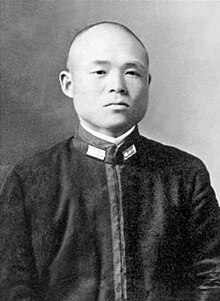Ōta Minoru
Ōta Minoru ( Japanese 大田 実 ; born April 7, 1891 in Nagara, Chiba , † June 13, 1945 in Okinawa ) was an admiral of the Imperial Japanese Navy , who commanded the naval ground forces at the Battle of Okinawa . He committed suicide in his command bunker suicide and was posthumously for Kaigun-Chūjhō (German Vice Admiral ) transported.
Military career
He graduated in 1913 as the 64th of 118 cadets of the 41st class of the Imperial Japanese Naval Academy.
At the Battle of Shanghai (1932) in 1932 he was given command of a battalion of the Navy's Special Landing Forces (SNLF). In 1936 he was named first officer of the battleship Yamashiro . In 1937 he received his first command as the captain of the fleet tanker Tsurumi . In December 1937 he was promoted to Kaigun-Daisa (German sea captain ).
At the beginning of the Second Sino-Japanese War , Ōta was given command of the 6th Kure Regiment of the SNLF. In 1941 the command of the SNLF of the China fleet followed near Wuhan in China . The following year he returned to Japan and was entrusted with the command of the 2nd SNLF. He was promoted to Rear Admiral and commanded the 8th Naval Special Landing Forces on New Georgia at the Battle of New Georgia in June and August 1943. He then served in various administrative functions until January 1945 in Japan.
He was transferred to Okinawa in January 1945 to command the Japanese navy's ground forces in the anticipated invasion by Allied forces. On Okinawa, Ōta commanded a force with a nominal strength of 10,000 men. Half, however, were civilian workers drafted into service with minimal military training. The other half were gunners from various naval vessels, with little experience in land combat. Allied sources about his role as commander of the naval ground forces in Okinawa are conflicting. Some consider Ōta capable of organizing the naval ground forces. To lead his soldiers aggressively against the Allied forces as a powerful force and to slowly withdraw to the fortified Oroku Peninsula.
Japanese 32nd Army Colonel Hiromichi Yahara describes a misunderstanding when ordering the Navy Ground Forces to withdraw from the Oroku Peninsula in order to support the Army further south. On or about May 24, umta began preparations for the withdrawal of all naval elements in support of the army to the south of the island. He destroyed most of the heavy equipment, stocks of ammunition, and even personal weapons. In mid-March, the 32nd Japanese Army ordered Ōta back to the Oroku Peninsula, citing a timing error (explanations vary). The naval ground forces returned to their previous positions without heavy weapons. Half of the troops even ran out of rifles. The Americans, who had not noticed the initial withdrawal, now attacked. They cut the peninsula off from the rest of Okinawa through attacks from the north on land and one final sea landing. On June 11, 1945, the 6th Marine Division was able to encircle the naval headquarters. On June 12th at 4:00 pm Ōta sent his last message to the 32nd Japanese Army. Many marines, like Ōta himself, then killed themselves with all kinds of weapons. Ōta shot himself with a pistol.
Report on the situation of the population on June 6th
On June 6, 1945, he sent a report to the Vice Minister of the Navy . This report later became known because it described the situation of the civilian population from the point of view of a Japanese commander shortly before the end of the defense.
literature
- George Feifer: The Battle of Okinawa: The Blood and the Bomb . The Lyons Press, 2001, ISBN 1-58574-215-5 .
Web links
- Hiroshi Nishida: Imperial Japanese Navy . Retrieved November 10, 2008.
Individual evidence
- ^ Feifer, George (2001). The Battle of Okinawa: The Blood and the Bomb. The Lyons Press.
- ↑ http://kaigungou.ocvb.or.jp/pdf/eigopan.pdf
| personal data | |
|---|---|
| SURNAME | Ōta, Minoru |
| ALTERNATIVE NAMES | Ōta, Kaigun-Chūjhō; 大田 実 (Japanese) |
| BRIEF DESCRIPTION | Admiral of the Imperial Japanese Navy who commanded naval ground forces at the Battle of Okinawa |
| DATE OF BIRTH | April 7, 1891 |
| PLACE OF BIRTH | Nagara, Chiba |
| DATE OF DEATH | June 13, 1945 |
| Place of death | Okinawa |



